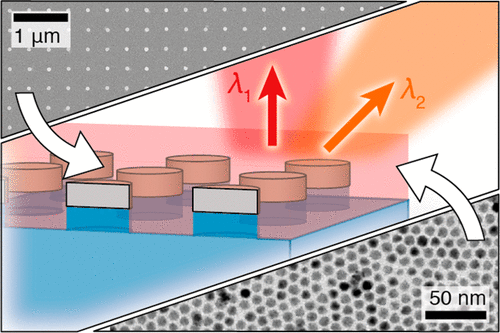Our official English website, www.x-mol.net, welcomes your
feedback! (Note: you will need to create a separate account there.)
Dual-Wavelength Lasing in Quantum-Dot Plasmonic Lattice Lasers.
ACS Nano ( IF 15.8 ) Pub Date : 2020-03-11 , DOI: 10.1021/acsnano.9b09698 Jan M Winkler 1 , Max J Ruckriegel 1 , Henar Rojo 1 , Robert C Keitel 1 , Eva De Leo 1 , Freddy T Rabouw 1 , David J Norris 1
ACS Nano ( IF 15.8 ) Pub Date : 2020-03-11 , DOI: 10.1021/acsnano.9b09698 Jan M Winkler 1 , Max J Ruckriegel 1 , Henar Rojo 1 , Robert C Keitel 1 , Eva De Leo 1 , Freddy T Rabouw 1 , David J Norris 1
Affiliation

|
Arrays of metallic particles patterned on a substrate have emerged as a promising design for on-chip plasmonic lasers. In past examples of such devices, the periodic particles provided feedback at a single resonance wavelength, and organic dye molecules were used as the gain material. Here, we introduce a flexible template-based fabrication method that allows a broader design space for Ag particle-array lasers. Instead of dye molecules, we integrate colloidal quantum dots (QDs), which offer better photostability and wavelength tunability. Our fabrication approach also allows us to easily adjust the refractive index of the substrate and the QD-film thickness. Exploiting these capabilities, we demonstrate not only single-wavelength lasing but dual-wavelength lasing via two distinct strategies. First, by using particle arrays with rectangular lattice symmetries, we obtain feedback from two orthogonal directions. The two output wavelengths from this laser can be selected individually using a linear polarizer. Second, by adjusting the QD-film thickness, we use higher-order transverse waveguide modes in the QD film to obtain dual-wavelength lasing at normal and off-normal angles from a symmetric square array. We thus show that our approach offers various design possibilities to tune the laser output.
中文翻译:

量子点等离子体激元激光器中的双波长激光发射。
图案化在基板上的金属粒子阵列已经成为芯片上等离激元激光器的有前途的设计。在此类设备的过去示例中,周期性粒子提供了单个共振波长的反馈,并且有机染料分子被用作增益材料。在这里,我们介绍了一种基于模板的灵活制造方法,该方法为银粒子阵列激光器提供了更广阔的设计空间。我们集成了胶体量子点(QD),而不是染料分子,它们提供了更好的光稳定性和波长可调性。我们的制造方法还使我们能够轻松地调整基板的折射率和QD膜厚度。利用这些功能,我们不仅演示了单波长激光发射,还通过两种不同的策略。首先,通过使用具有矩形晶格对称性的粒子阵列,我们从两个正交方向获得反馈。可以使用线性偏振器分别选择该激光器的两个输出波长。其次,通过调整QD膜的厚度,我们在QD膜中使用了更高阶的横向波导模式,以从对称方阵获得法向和非法向角的双波长激光。因此,我们证明了我们的方法提供了各种设计可能性来调整激光输出。
更新日期:2020-03-11
中文翻译:

量子点等离子体激元激光器中的双波长激光发射。
图案化在基板上的金属粒子阵列已经成为芯片上等离激元激光器的有前途的设计。在此类设备的过去示例中,周期性粒子提供了单个共振波长的反馈,并且有机染料分子被用作增益材料。在这里,我们介绍了一种基于模板的灵活制造方法,该方法为银粒子阵列激光器提供了更广阔的设计空间。我们集成了胶体量子点(QD),而不是染料分子,它们提供了更好的光稳定性和波长可调性。我们的制造方法还使我们能够轻松地调整基板的折射率和QD膜厚度。利用这些功能,我们不仅演示了单波长激光发射,还通过两种不同的策略。首先,通过使用具有矩形晶格对称性的粒子阵列,我们从两个正交方向获得反馈。可以使用线性偏振器分别选择该激光器的两个输出波长。其次,通过调整QD膜的厚度,我们在QD膜中使用了更高阶的横向波导模式,以从对称方阵获得法向和非法向角的双波长激光。因此,我们证明了我们的方法提供了各种设计可能性来调整激光输出。










































 京公网安备 11010802027423号
京公网安备 11010802027423号